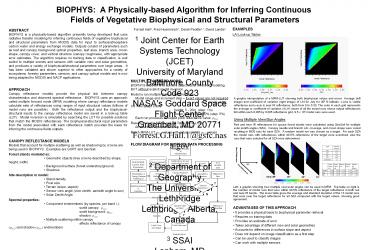BIOPHYS: A Physically-based Algorithm for Inferring Continuous - PowerPoint PPT Presentation
1 / 1
Title:
BIOPHYS: A Physically-based Algorithm for Inferring Continuous
Description:
Title: No Slide Title Author: K. Fred Huemmrich Last modified by: K. Fred Huemmrich Created Date: 11/26/2003 7:02:48 PM Document presentation format – PowerPoint PPT presentation
Number of Views:34
Avg rating:3.0/5.0
Title: BIOPHYS: A Physically-based Algorithm for Inferring Continuous
1
BIOPHYS A Physically-based Algorithm for
Inferring Continuous Fields of Vegetative
Biophysical and Structural Parameters
EXAMPLES LAI Look-up Tables
Forrest Hall1, Fred Huemmrich1, Derek Peddle2,1,
David Landis3 1 Joint Center for Earth Systems
Technology (JCET) University of Maryland
Baltimore County Code 923 NASA's Goddard Space
Flight Center Greenbelt, MD 20771 Forrest.G.Hall.1
_at_gsfc.nasa.gov 2 Department of Geography The
University of Lethbridge Lethbridge, Alberta,
Canada 3 SSAI Lanham, MD
ABSTRACT BIOPHYS is a physically-based algorithm
presently being developed that uses radiative
transfer modeling for inferring continuous fields
of vegetative biophysical and structural
parameters from MODIS data for input to
surface/atmosphere carbon water and energy
exchange models. Outputs consist of parameters
such as leaf and canopy background optical
properties, leaf area, branch area, crown shape,
canopy cover, and vertical structure (canopy
roughness), with appropriate error estimates. The
algorithm requires no training data or
classification, is well suited to multiple scenes
and sensors with variable view and solar
geometries, and produces a variety of
biophysical/structural parameters over large
areas. It has been validated and shown superior
to other approaches for a variety of ecosystems,
forestry parameters, sensors, and canopy optical
models and is now being adapted for MODIS and
NACP applications. APPROACH Canopy reflectance
models provide the physical link between canopy
characteristics and observed spectral
reflectance. BIOPHYS uses an approach called
multiple forward mode (MFM) modeling where canopy
reflectance models calculate sets of reflectances
using ranges of input structural values (billions
of model runs are possible). Both the
reflectance output and the biophysical-structural
inputs to the canopy reflectance model are saved
in a look-up table (LUT). Model inversion is
simulated by searching the LUT for possible
solutions that match the MODIS reflectances. The
biophysical-structural input parameters from the
model associated with each reflectance match
provides the basis for inferring the continuous
fields outputs. CANOPY REFLECTANCE
MODELS Models that account for multiple
scattering as well as shadowing by crowns are
being used in BIOPHYS. Examples are GORT and
GeoSail. Forest stands modeled as Geometric
objects (tree crowns described by shape, height,
width) Background surface (forest
understory/ground) Shadows Site description
in model Stand density Pixel
size Terrain (slope, aspect) Sensor view
angle (view zenith, azimuth angle to
sun) Solar Zenith Angle Spectral
properties Component endmembers (by species,
per band ?) sunlit canopy ?c(?) sunlit
background ?b(?) shadow ?s(?) Multiple
scattering within canopy affects reflectance
of canopy (?c(?)) and shadow (?s(?)) endmembers
MULTIPLE FORWARD MODE BIOPHYS uses MFM to achieve
objectives of inversion modeling, BUT without
explicit model inversion. Model is run multiple
times in forward mode Model range and
increment step Exact values are not
required e.g. crown width 0.5 - 4m (step
0.5m) height 5 - 20m (step 1m)
crown closure 0 - 100 (step 5) Each
run produces an output pixel reflectance value
?T(?) Results stored in MFM Look-up Table
(MFM-LUT) All structural inputs retained in
MFM-LUT Match MFM-LUT ?T(?) values with actual
satellite ?T(?) values FLOW DIAGRAM FOR BIOPHYS
DATA PROCESSING
A graphic interpretation of a MFM-LUT showing
both biophysical values and errors. Average (left
image) and coefficient of variation (right image)
of LAI for July for 45º N latitude, x-axis is
visible reflectance and y-axis is near IR
reflectance, both from 0 to 0.30. The color in
each grid represents the average or coefficient
of variation of LAI values of all the model runs
whose output reflectances fell within each 0.005
by 0.005 reflectance grid. 9.5 x 109 model runs
were used. Using Multiple View/Sun Angles Red
and near IR reflectances for spruce forest stands
were calculated using GeoSail for multiple solar
zenith angles (SZA). Canopy needle and branch
LAI, coverage, and crown shape were varied
resulting in 6930 runs for each SZA. A random
model run was chosen as a target. For each SZA
the model runs with reflectances within 0.5
reflectance of the target were examined, also the
runs that were selected for all SZA were
determined.
Left, a graphic showing how multiple view/solar
angles can be used in MFM. Top table on right is
the number of model runs that were within 0.5
reflectance of the target reflectance in both red
and near IR bands. The lower table gives the
average and standard deviation of the 13 model
runs that were near the target reflectance for
all SZA compared with the target values, showing
good agreement. ADVANTAGES OF THIS APPROACH It
provides a physical basis to biophysical
parameter retrieval Requires no training data
Provides an estimate of error Takes advantage
of different view and solar geometries Accounts
for differences in surface slope and aspect
Does not depend on image classification as a
first step Can be used to classify images
Can work with multiple sensors































